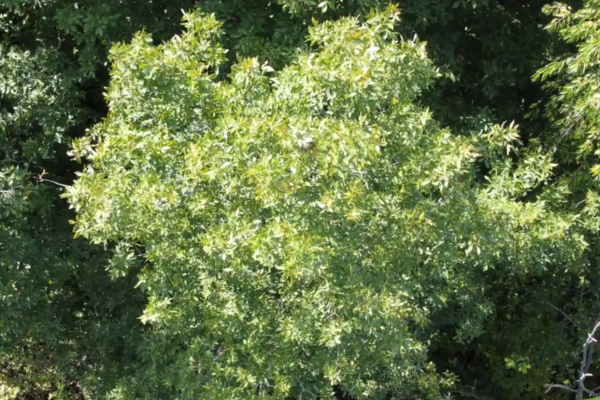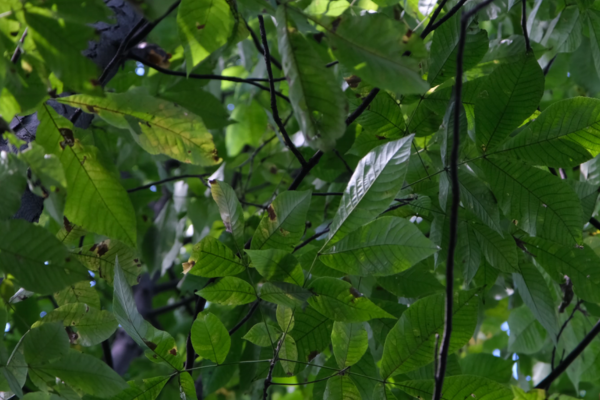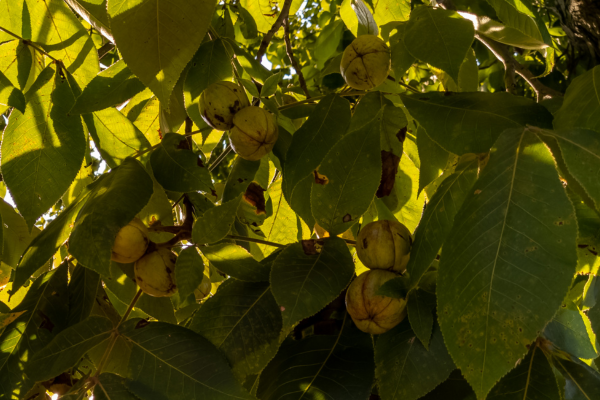Scientific name: Carya ovata
Carya = Derived from the Greek word κᾰρύα (pronounced Kah - ree - a), meaning walnut. In Greek mythology, a Laconian princess named Carya was involved with the god Dionysus. Upon her death, Dionysus memorialized her by changing her into a walnut tree.
ovata = Derived from the Latin word õvātus meaning egg-shaped, referring to the ovular shape of its leaves.
Shagbark Hickory is found growing in southern Ontario, including along the St. Lawrence River. The tree got its name due to its characteristic bark, which separates into long strips as it matures. The strips eventually loosen from the tree, giving it a “shaggy” appearance. Shagbark Hickory produces round, sweet tasting nuts (3-4.5 centimeters in length) that are a favourite among squirrels and are also eaten by other birds and mammals like chipmunks and black bears. The tree also makes a good home for cavity-nesting birds and songbirds.
Shagbark Hickory grows best in moist, well-draining, rich soil. While it can tolerate some shade, they thrive in full sun. This tree can also handle occasional drought and flooding conditions. Shagbark Hickory often grows on hillsides and valleys where the soil is rich and moist. When mature, this slow growing tree can reach heights between 20 to 30 meters and live to approximately 200 years old.
Shagbark Hickory is a popular choice for lumber. Its strong wood can be used to make durable and shock resistant products such as flooring, tool handles, furniture, and sporting equipment like baseball bats and skis. The wood burns for a very long time, making it excellent for bonfires or as charcoal to give cooking a hickory flavouring. Shagbark Hickory is also Ontario’s most important source of edible hickory nuts. These sweet nuts are similar in taste to pecans and are often used in baked goods. The sap from the tree can also be boiled down into a sweet syrup. To see a recipe for Shagbark Hickory syrup, check out this video "How to Make Hickory Syrup."
The signs and tags at the Edible Forest are in place for educational purposes and should not necessarily be used for identification. Visitors may identify, consume, forage, and prepare plants from the Edible Forest at their own risk. Visitors should be aware that ingesting toxic or poisonous plants could lead to life-threating injuries or allergic reactions. In the event of an emergency, call 911.
Sources:
ECOsostenibile. 2022. Carya ovata. [online] Available: https://antropocene.it/en/2022/12/13/carya-ovata-2/
OMNR, 2022. Ontario Ministry of Natural Resources: Ontario Tree Atlas. [online] Available: https://www.ontario.ca/page/shagbark-hickory
OMNR. Ontario's Tree Atlas. [online] Available: https://pecmastergardeners.ca/wp-content/uploads/2020/07/Ontarios-Tree-Atlas.pdf
The Morton Arboretum. 2023. Shagbark hickory. [online] Available: https://mortonarb.org/plant-and-protect/trees-and-plants/shagbark-hickory/
University of Guelph. Guelph Arboretum: Shagbark Hickory - Carya ovata. [online] Available: https://arboretum.uoguelph.ca/thingstosee/trees/shagbarkhickory
%20938-3611%20info%40rrca_on_ca%20rrca_on_catrees%20(400%20%C3%97%20200%20px)%20(1).jpg)
(1) Source: Ontario Tree Atlas (ontario.ca/page/tree-atlas)


 Shagbark hickory develops a large, oval shaped crown, reaching heights of 30 meters.
Shagbark hickory develops a large, oval shaped crown, reaching heights of 30 meters.

.png)